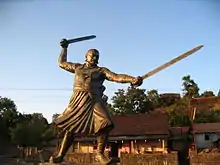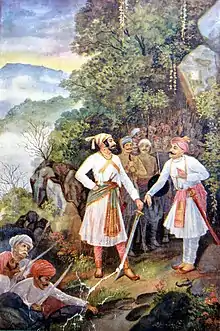Baji Prabhu Deshpande
Baji Prabhu Deshpande (c. 1615-1660) was a commander of Maratha king Chatrapati Shivaji Maharaj, the founder of the Maratha empire. The legend of Baji Prabhu is linked with an important rear guard battle enabling Chatrapati Shivaji Maharaj's escape from Panhala fort; he was the hero who sacrificed his life for his king.
| Baji Prabhu Deshpande | |
|---|---|
 Baji Prabhu Deshpande Statue in Panhala Fort | |
| Minister to Chatrapati Shivaji Maharaj Sardar of Ambarnath | |
| Born | est. 1615 Shind (Parde), Bhor Pune district, (Maharashtra) |
| Died | 14/07/1660 Pavan Khind at Vishalgad (Kolhapur district, Maharashtra) |
Early life
Baji Prabhu was 15 years older than Shivaji, which indicates he was born around 1615. He was born in a Chandraseniya Kayastha Prabhu family.[1][2]
Battle of Pavan Khind

After defeating Afzal Khan and the rout of the Bijapuri army at Pratapgad, Shivaji continued to push deep into Bijapuri territory. Within a few days, the Marathas captured Panhala fort (near the city of Kolhapur). Meanwhile, another Maratha force, led by Netaji Palkar, pushed straight on towards Bijapur. Bijapur repulsed this attack, forcing Shivaji, some of his commanders and soldiers to retreat to Panhala fort.
The Bijapuri force was led by Siddhi Johar, an Abyssinian general. Discovering Shivaji's location, Johar laid siege to Panhala. Netaji Palkar made repeated attempts to break the Bijapuri siege from outside, but these failed.
Finally, a very audacious and high-risk plan was hatched and put into action: Shivaji, Baji Prabhu Deshpande with a select band of troops would attempt to break through the siege at the night, and make for Vishalgad. In order to deceive the Bijapuri forces, who would give a chase once they found that Shivaji had broken the siege, Shiva Nhavi, who had an uncanny physical resemblance to Shivaji, volunteered to dress like the king and let himself be captured.
On a stormy full moon's night (night of Guru Pournima, Ashadh Paurnima) a band of 600 select men, led by Baji Prabhu and Shivaji, broke through the siege. They were hotly pursued by the Bijapuri force. As planned, Shiva Nhavi allowed himself to be captured and taken back to the Bijapuri camp, fully comprehending that he would be put to death once the charade was discovered. This sacrifice, however, gave the fleeing Maratha force some breathing space.
As soon as the Bijapuri force realized their mistake, the chase was on again, led by Siddhi Masood, the son-in-law of Siddhi Johar. Near the pass of Ghodkhind (Horse's Pass), the Marathas made a final stand. Shivaji and half of the Maratha force pushed for Vishalgadh, while Baji Prabhu, his brother Phulaji and the remaining Bandal Sena of about 300 men blocked the pass and fought against 10000 Bijapuri soldiers in the Ghodkhind Pass for more than 18 hours.
Tradition and legend describe feats of valour displayed by the Marathas during this rear-guard action. Baji Prabhu had mastered the art of using a weapon called "Dand Patta". Through the entire battle, Baji Prabhu, even though grievously injured, continued fighting, inspiring his men to fight on until Shivaji's safe journey to Vishalgadh was signaled by the firing of three cannon volleys. It should be mentioned that when Shivaji approached Vishalgad with 300 men, the fort was already under siege by Bijapuri sardars named Suryarao Surve and Jaswantrao Dalvi. Shivaji with his 300 men had to defeat Surve to reach the fort.
Accolades
The Ghodkhind pass was subsequently named Pavan Khind ("Holy Pass") by Shivaji, in honor of the sacrifice of Baji Prabhu and his troops.
Sri Aurobindo, composed an English poem, "Baji Prabhou"., in 1909, that describes his heroic sacrifice at the battle at the Panhala Fort.[3]
Indian independence activist and politician Vinayak Damodar Savarkar wrote a Ballad on Baji Prabhu but it was banned by the colonial British government. This ban was lifted on May 24th, 1946.[4]
A street is named after him in Thane and Ambarnath, India, and a film based his story was made in 1929.[5] A square is named after Baji Prabhu Deshpande in Nagpur City (Dist Nagpur) and Dombivali (District Thane - Maharashtra).
In 2002, it was reported that political leaders would unveil a bust of Baji Prabhu at the Chandraseniya Kayastha Prabhu trust office in the city of Pune on July 13, Baji Prabhu's death anniversary. Ashok Deshpande, president of the trust said that the bust has been sculpted by noted city sculptor Vivek Khatavkar under the guidance of history scholars Babasaheb Purandare and Ninad Bedekar.[6]
Descendants
One of Baji Prabhu's descendant, Ramchandra Kashinath Deshpande, was an Indian freedom fighter against the British rule, educationalist and social activist who worked in Dhule, Jalgaon, and Pune for encouraging education. He participated in the Quit India Movement during the British rule and was imprisoned for 19 months in the Kolhapur Central Jail. He was felicitated after Independence by the then Prime Minister Indira Gandhi. For his social work he was given the title of ‘Special Executive Magistrate’ by the Maharashtra government in 1989.[7][8]
See also
- Tanaji Malusare, another Sardar known for his valor.
- Netaji Palkar, Sardar Senapati (Commander-in-Chief) of Shivaji.
References
- Kantak, M. R. (1978). "The Political Role of Different Hindu Castes and Communities in Maharashtra in the Foundation of the Shivaji's Swarajya". Bulletin of the Deccan College Research Institute. 38 (1): 46. JSTOR 42931051.
- Balkrishna Govind Gokhale (1988). Poona in the eighteenth century: an urban history. Oxford University Press. p. 112.
The early great hero of the CKP community was Baji Prabhu Deshpande, who sacrificed his own life in 1660 to enable Shivaji to escape the Mughals at Vishalgad.
- Mapping the Nation: An Anthology of Indian Poetry in English, 1870–1920. Anthem Press. June 25, 2012. ISBN 9781783080755.
- Derek Jones, ed. (December 1, 2001). Censorship: A World Encyclopedia. Routledge. ISBN 9781136798634.
- "Baji Prabhu Deshpande - Film". IMDb. Retrieved May 2, 2012.
- "Times of India - Baji Prabhu's bust to be unveiled in city (Juny 2002)".
- "Shivaji lieutenant's heir files plea against Maharashtra government".
- "Freedom fighter's land used as cremation ground, daughter moves Bombay High Court".
External links
| Wikimedia Commons has media related to Baji Prabhu Deshpande. |